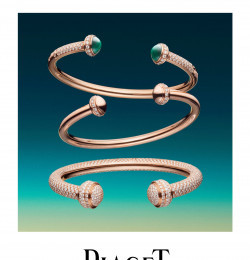

Piaget
Geneva
Switzerland
About
founded by
Georges Piaget
about
Piaget SA is a Swiss luxury watchmakers and jewellers, founded in 1874 by Georges Piaget in the village of La Côte-aux-Fées. The company belongs to the Swiss Richemont group, specialists in the luxury goods industry.
The company was founded as a manufacturer of watch movements but began marketing its own line of prestigious watches in the 20th century.
In 2008, The Luxury Institute jewellery brand study ranked Piaget as the 6th most prestigious jewellery brand.
In 1874, Georges Edouard Piaget set up his first workshop on the family farm, situated in the small village of La Côte-aux-Fées in the Swiss Jura mountains. Dedicated to crafting pocket watches and high-precision clock movements for prestigious brands, the Piaget name was soon to travel beyond the borders of the Neuchâtel region. In 1911, Timothée Piaget, the son of Georges Piaget, took over the family firm. The Manufacture has been dedicated to the production of wrist watches ever since.
Under the guidance of the founder’s grandsons, Gérald and Valentin Piaget, the Piaget brand became a registered trademark in 1943. Since then, the Manufacture at La Côte-aux-Fées has produced its own creations and has undergone considerable international expansion. As a result of this expansion, the family business opened a new factory in 1945, again in La Côte-aux-Fées.
In 1957, the manufacture at La Côte-aux-Fées brought out the Calibre 9P, the first ultra-thin (2 mm), hand-wound mechanical movement. Then, in 1960, the Piaget watchmakers developed the Calibre12P, the thinnest automatic movement in the world with a thickness of 2.3 mm (made official by an entry in the Guinness Book of Records). The Piaget collection was diversifying. In addition to coin watches, ring watches, brooch watches and cufflink watches, Piaget created their first pieces of jewellery. In 1957, the Emperador men’s watch was launched and since it's relaunch in 1999 become one of the brand’s emblematic models. The company’s expansion led to the opening of a new factory in Geneva, dedicated to jewellery and, in 1959, their first boutique.
In 1964, Piaget presented their first watches with dials worked in precious stones: lapis-lazuli, turquoise, onyx and tiger's eye. Piaget then launched the cuff watch, which became a symbol of fine watchmaking. 1976 saw the launch of the Calibre 7P, a quartz movement. The Piaget Polo watch with its avant-garde style, was brought out in 1979 and became one of the brand’s iconic models. The Dancer collection, launched in 1986, met with similar success. Under the presidency of Yves Piaget since 1980, Piaget have continued to cultivate the status of “watchmaker-jeweller”.
The luxury Vendôme group, now Richemont, purchased the Piaget Manufacture in 1988. In the 1990s, several new collections were launched: Possession, Tanagra, Limelight and Miss Protocole with its interchangeable straps. Regarding watches, Piaget brought out the Altiplano model and in 1999 reinvented one of their classics, the Emperador line. Watchmaking was regrouped in one collection: Black Tie.
In 2001, a new Piaget Haute Horlogerie manufacture was opened in Plan-les-Ouates, just outside Geneva. The movements continued to be produced at La Côte-aux-Fées, the family’s historic birthplace. The new building grouped together over 40 professions in the fields of watchmaking and jewellery. The same year, Piaget added a youthful touch to the Polo watch from the 1970s and launched the Magic Reflections collection. The Manufacture developed several lines of mechanical movements and in 2002 brought out the first Piaget Manufacture tourbillon movement, the Calibre 600P, the thinnest tourbillon in the world with 3.5 mm thickness. In 2004, Piaget celebrated the 130th anniversary of their creation.
Who Wears It
Sienna Miller, Jackie Kennedy, Gina Lollobrigida, Andy Warhol

